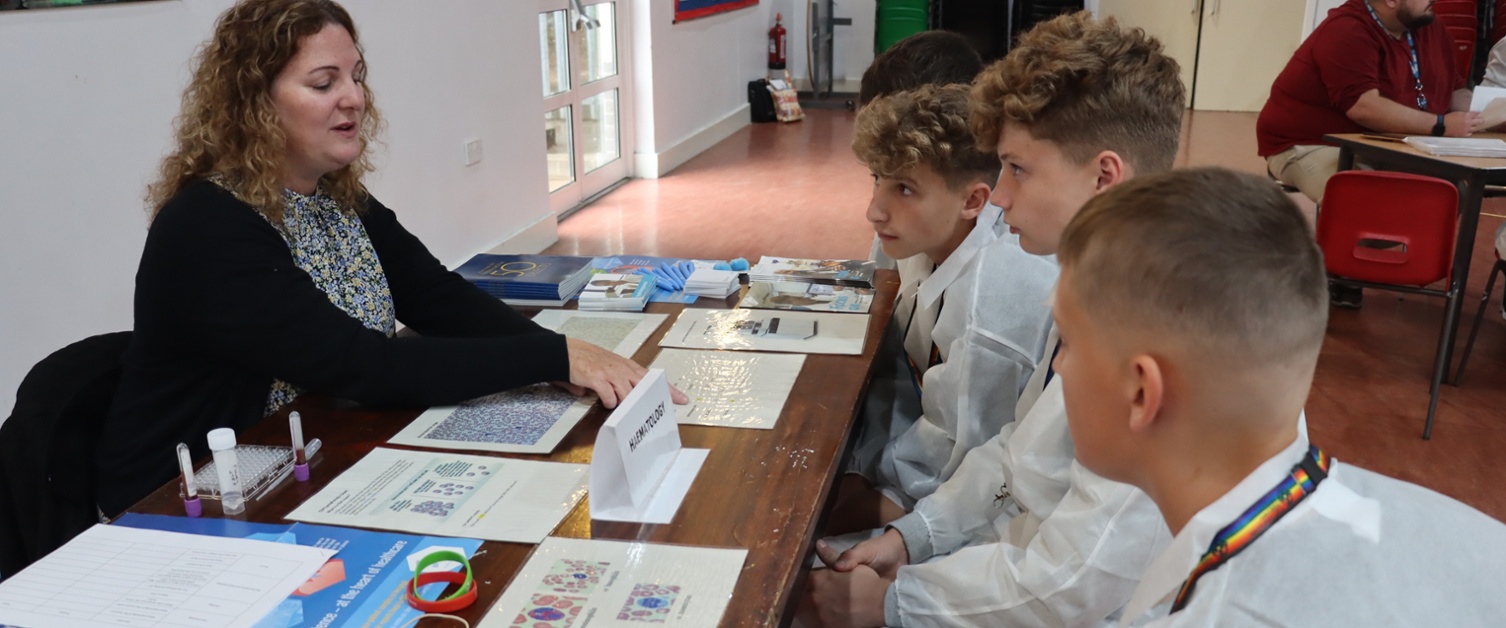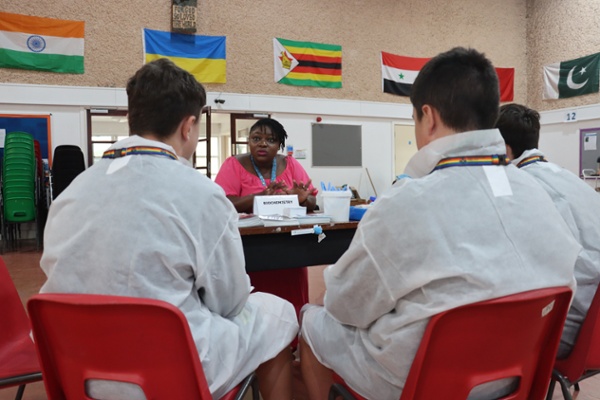Top marks for pathology staff after school visit to highlight exciting career opportunities

Pathology staff are top of the class with Port Talbot pupils after a successful school visit to shine a light on their vital work.
Year 9s at St Joseph’s Catholic School and Sixth Form got a ‘hands-on’ insight into specialisms including haematology, virology and radiology by following clues to discover why a fictitious patient was feeling unwell.
Equipment including a microscope, pulse oximeter and pathology slides were brought to the school hall to introduce children to diagnostic tools as they asked questions, made notes and then presented a diagnosis.
The visit, a first for the area, was devised and run by Public Health Wales, who provided the majority of staff on the day in collaboration with a team from Swansea Bay.
Further school visits are planned to step up efforts to show just how interesting and rewarding a role in pathology or biomedical sciences can be.
“This was a first for us, and I’m delighted to say it went really well,” said laboratory medicine training manager Kimberly Lewis, pictured below.

“It was great to have the opportunity to open up the minds of young scientists to what we do.
“The teaching staff were delighted and said that some of the children were more engaged in the class than they’ve ever seen them before, which is fantastic.
“It’s so important we make sure we are training enough biomedical scientists for the next few decades, so we’re trying to do our bit by being as proactive as possible.
“The St Joseph’s visit is one of a number we are planning to help get our message out to Year 9 pupils, particularly those who are looking to take biology for GCSE.
“People think of the health service as being all about the doctors and nurses. It’s great when children show an interest in working in those areas but we also want to show them the amazing career opportunities in pathology.
“It’s not widely known, but 70 per cent of all diagnoses is based on results reported by the laboratory.
“So, when a doctor explains a treatment plan to a patient, it’s highly likely results from tests completed by a pathologist will have formed the basis for that plan.
“Laboratory medicine has advanced tremendously. We monitor a patient’s progress and recommend medication. We get to know a patient probably better than they know themselves, often without ever meeting them.

“It can be a very emotional experience. We’ve been called lots of things over the years. ‘Behind the curtain heroes’ is one.
“If someone arrives in the Emergency Department and needs a blood transfusion, we provide potentially life-saving information about which blood group or blood products the patient needs.
“In cases of patients who are unfortunately not responding to their treatment, the laboratory can perform simple tests to help determine brain activity.
“There is a perception perhaps that introverts go into pathology, the kind of people who would rather be in the background. That’s not really the case, it’s a fantastic career for anyone and it is hugely rewarding to know the role you play in saving lives.”
The visit to St Joseph’s was the latest in a string of initiatives aimed at increasing awareness of the role played by biomedical science in healthcare, and the kind of career options available.
Kimberly added: “We staged laboratory tours for the public as part of National Pathology Week in June, which was laboratory medicine and cellular pathology only.
“That proved a real success and we have had follow-up emails regarding getting into the profession.
“As part of Biomedical Science Day, also in June, we hosted a stand at Singleton Hospital which allowed us to meet some of our service users and answer any questions they had.
“It’s all good work. We have also led the way on developing the resources for the pathology pathway of the Level 4 Diploma in Healthcare Science.
“These will now be used nationwide and they are a valuable part of the grow-your-own approach to try and retain staff in our area.
“A part-time degree will be available from September 2024 as the final part of taking the same approach to developing biomedical scientists from the local communities.
“We know we can’t take recruitment for granted, so we’re working hard to capture people’s imagination and bring them into the profession.”

Meanwhile, one of the pupils taking part in the St Joseph’s pathology visit said: “The visit was good fun; the bit I probably enjoyed best was working through the brain scans. There was a bit of detective work needed to see what was wrong with the patient. We got the answer in the end.
“I’m not sure really what I’d like to do when I leave school, but I enjoyed the way we had to come up with a diagnosis.”
The school is now keen to link up again with the health board if and when future projects arise.
“The day was a roaring success and I’ve had some incredible feedback from both the pupils and our staff,” said teacher Tilly Davies, who played a key part in organising the visit.
“We’d be more than happy to work with Swansea Bay University Health Board staff again on any future projects like this one.”
Rydym yn croesawu gohebiaeth a galwadau ffôn yn y Gymraeg neu'r Saesneg. Atebir gohebiaeth Gymraeg yn y Gymraeg, ac ni fydd hyn yn arwain at oedi. Mae’r dudalen hon ar gael yn Gymraeg drwy bwyso’r botwm ar y dde ar frig y dudalen.
We welcome correspondence and telephone calls in Welsh or English. Welsh language correspondence will be replied to in Welsh, and this will not lead to a delay. This page is available in Welsh by clicking ‘Cymraeg’ at the top right of this page.